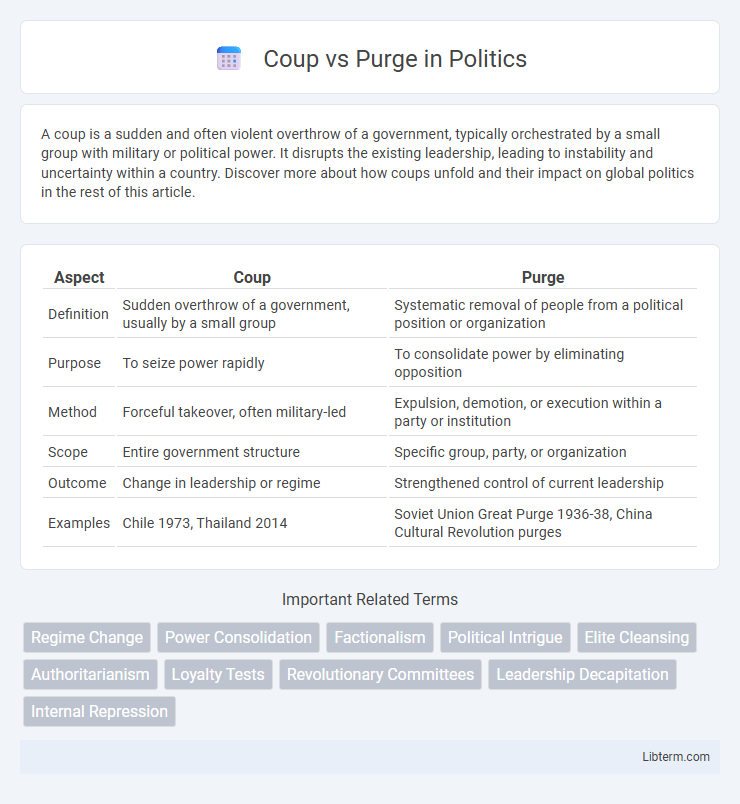A coup is a sudden and often violent overthrow of a government, typically orchestrated by a small group with military or political power. It disrupts the existing leadership, leading to instability and uncertainty within a country. Discover more about how coups unfold and their impact on global politics in the rest of this article.
Table of Comparison
| Aspect | Coup | Purge |
|---|---|---|
| Definition | Sudden overthrow of a government, usually by a small group | Systematic removal of people from a political position or organization |
| Purpose | To seize power rapidly | To consolidate power by eliminating opposition |
| Method | Forceful takeover, often military-led | Expulsion, demotion, or execution within a party or institution |
| Scope | Entire government structure | Specific group, party, or organization |
| Outcome | Change in leadership or regime | Strengthened control of current leadership |
| Examples | Chile 1973, Thailand 2014 | Soviet Union Great Purge 1936-38, China Cultural Revolution purges |
Understanding Coups and Purges
Coups and purges represent distinct forms of political power shifts with coups involving sudden, often violent seizures of government control typically executed by military or political factions. Purges systematically eliminate opponents or perceived threats within a political organization or government, frequently through expulsions, imprisonments, or executions to consolidate authority. Understanding coups requires examining rapid regime changes, while purges emphasize internal restructuring and control maintenance within ruling elites.
Defining a Coup: Key Characteristics
A coup, or coup d'etat, involves the sudden overthrow of a government typically executed by a small group within the existing state structure, such as military officers or political insiders. Key characteristics include abrupt seizure of power without widespread public involvement, limited violence compared to revolutions, and the goal of replacing the top leadership rather than altering the entire political system. Unlike purges, which target specific individuals or groups within a regime to consolidate control, coups aim at complete regime change through swift, decisive action.
What Constitutes a Purge?
A purge involves the systematic removal or elimination of individuals deemed disloyal or undesirable within an organization or government, often characterized by arrests, dismissals, or executions. Unlike a coup, which seeks to overthrow or replace existing leadership, a purge aims to consolidate power by cleansing internal threats and dissenters. Historical examples include Stalin's Great Purge, where millions were targeted to enforce ideological conformity and secure absolute control.
Historical Examples of Coups
Historical examples of coups highlight sudden, often violent seizures of power, such as the 1973 Chilean coup led by General Augusto Pinochet, which overthrew President Salvador Allende. Coups typically involve a small group within the military or government acting swiftly to replace existing leadership, as seen in the 1991 Soviet coup attempt against Mikhail Gorbachev. These events contrast with purges, which systematically eliminate political rivals after consolidating power, underscoring different methods of regime change in political history.
Notable Political Purges in History
Notable political purges often involve the systematic removal of perceived enemies within a regime, distinguishing them from coups, which are sudden seizures of power. Historical examples include Stalin's Great Purge (1936-1938), where millions were executed or imprisoned to consolidate control over the Soviet Union. Mao Zedong's Cultural Revolution (1966-1976) further exemplifies political purges aimed at eliminating opposition and reinforcing ideological conformity in China.
Motivations Behind Coups and Purges
Coups are primarily motivated by a desire to seize political power quickly, often driven by dissatisfaction with existing leadership or perceived government corruption. Purges aim to eliminate opposition and consolidate power within an established regime, typically fueled by fears of dissent or threats to authority. Both mechanisms reflect deep political instability but serve different strategic purposes in controlling or reversing power dynamics.
Methods and Tactics: Coup vs Purge
A coup typically involves rapid, coordinated actions by a small group to seize control of government institutions, often relying on military force, strategic alliances, and surprise to quickly remove current leadership. In contrast, a purge systematically eliminates political rivals or dissenters through arrests, expulsions, or executions over an extended period, aiming to consolidate power by instilling fear and reducing opposition within the party or organization. Both methods use coercion and manipulation, but coups emphasize swift power grabs, while purges focus on internal cleansing and long-term dominance.
Impacts on Political Stability
Coups frequently trigger immediate political instability by forcibly overthrowing existing governments, often leading to power vacuums and heightened uncertainty. Purges, by systematically eliminating political rivals and dissenting voices within a regime, can consolidate power but also breed fear and resentment, potentially destabilizing governance over time. Both tactics disrupt institutional continuity and undermine democratic processes, significantly impacting a nation's political stability.
International Reactions to Coups and Purges
International reactions to coups often involve widespread condemnation, imposition of sanctions, and calls for the restoration of legitimate governments, as seen in the global response to the 2021 Myanmar coup. Purges, typically internal political cleanups, elicit more restrained international reactions unless they destabilize regional security or involve human rights abuses, exemplified by concerns over Russia's political purges targeting dissenters. The United Nations and regional organizations like the African Union play pivotal roles in mediating post-coup crises and advocating for peaceful political transitions.
Coup vs Purge: Key Differences and Implications
A coup involves the sudden, often illegal overthrow of a government by a small group, typically military or political insiders, aiming to seize control without mass mobilization. A purge systematically removes political opponents or dissenters within a regime to consolidate power, often through arrests, expulsions, or executions. The key difference lies in a coup's focus on regime change versus a purge's goal of internal power stabilization, impacting political stability and governance differently.
Coup Infographic

 libterm.com
libterm.com